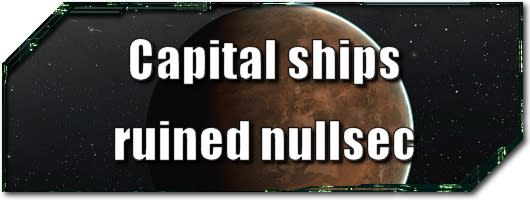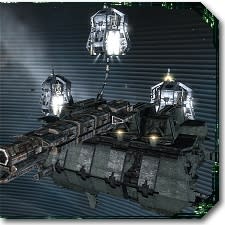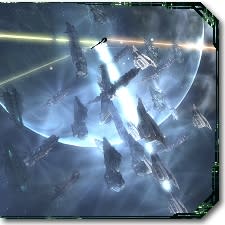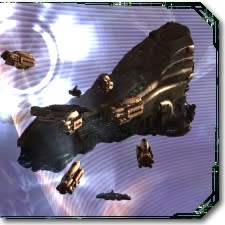EVE Evolved: Capital ships ruined nullsec
All throughout EVE Online's lifetime, compelling stories of incredible events, daring heists, and colossal battles with thousands of players have periodically surfaced and spread across the gaming media like wildfire. Most of the recent stories have been about record-breaking battles between huge alliances of players in the lawless depths of null-security space, and each one has been met with an influx of new players who want to participate. The surprising truth behind nullsec warfare, however, is that many of those on the front lines are simply fed up with the political state of the game.
In EVE's early years, the map was split between hundreds of small alliances, each of which slowly expanded its influence by conquering the star systems bordering its space. Skirmishes and pirate incursions were brief and commonplace, while border wars over territory were long and protracted affairs. Today's nullsec is a different animal entirely, with nearly the entire map carved up between two colossal mega-coalitions of alliances (N3/PL and CFC), each one internally held in a state of perpetually monotonous peace. No alliance in a coalition can break away and stand on its own for fear of being demolished by the others, and so all of nullsec is at peace with its neighbours and bored to tears by it.
In this edition of EVE Evolved, I examine how nullsec got to the state it's in now and why it's badly in need of an overhaul.
Logistics used to win wars
I had the privilege of living in nullsec with the Interstellar Starbase Syndicate alliance from 2005 to 2007, before large capital ship fleets became commonplace. If we wanted to move supplies into nullsec back then, we had to either risk hauling items 20 or more jumps through potentially pirate-infested space or get together fleets of a hundred or more pilots to protect a freighter convoy. Replacement ships were often built locally because shipping them in was too dangerous or time-consuming, and we even organised a few alliance-wide mining operations to rebuild the navy's ship reserves.
The alliance that could keep its pilots in ships typically won out in a protracted war back then, and alliances maintained diplomatic relations and border agreements with neighbours to keep supply lines neutral and secure. For a short period in EVE's history, it was even possible to starve an alliance out of a star system by setting up round-the-clock blockades to stop starbase fuel getting in. This forced the enemy to either abandon the system or attempt to break through the blockade with a fleet of its own, both desirable outcomes for the aggressor.
When alliances decided to go to war, they were typically limited to warring with their nearest neighbours because a steady supply of replacement ships and supplies was needed nearby and moving a large war stockpile across the map was impractical. Warring with nearby alliances also meant that securing your own supply lines had the side-effect of blocking the enemy's. In those days, war was truly won in the shipping lanes rather than the battlefield.
A universe on fire
Between 2005 and 2007, EVE slowly evolved from a place where small alliances picked border wars with each other to a universe on fire with ever-growing groups of alliances working together. The first Great Southern War at the end of 2006 kicked off with a fleet of around 200 capital ships from ISS, Lotka Volterra, and Mercenary Coalition working together to fight the Interstellar Alcohol Conglomerate and its allies. The presence of an LV titan prompted Russian alliance Against All Authorities to get its capital fleet involved, and the war quickly heated up. Unofficial coalitions formed as alliances from across EVE took sides, and a war erupted on a scale that had never been seen before.
That war foreshadowed things to come, in some ways predicting today's political stagnation of a universe held by massive coalitions. The proliferation of capital ships forever changed the nature of fleet warfare in EVE, and I don't think it's been a change for the better. Jump drives allow alliances to deploy their capital fleets anywhere in the game within minutes, and Titan Jump Portals let sub-capital fleets follow them. Supply lines no longer exist in any meaningful sense as they can't be easily disrupted, and the logistical challenges of EVE's early war machine have vanished. An individual player can now purchase whole fleets of replacement ships for his alliance in Jita and move them halfway across the map with very little risk or effort.
Force Projection ruined nullsec
The Dreadnought, Carrier, Mothership, and Titan capital ships were all introduced in 2005, but it took about a year for a significant number of people to train the skills to use them and afford the hefty price tags. The first titan wasn't even built until September 2006, but it wasn't long before capital fleet size and jump logistics were major deciding factors in wars. This fact was clearly demonstrated in mid 2007 when Mercenary Coalition famously waged a successful war on northern regions of EVE while also defending its home base in the deep south of Period Basis.
It became clear that a well-organised alliance could feasibly wage war on the opposite side of the map from its homeland and still return in time to defend its own territory. With a little co-ordination, multiple alliances lightyears apart could now join forces to wage war against a common enemy on the opposite side of the galaxy. Capital fleets have grown immeasurably since then, hundreds of titans are now in service, and small alliances have been forced to capitulate to larger entities or perish. With the limits on force projection range effectively dissolved, co-operative coalitions spanning the galaxy were inevitable.
CCP is obviously keen to promote the huge battles that occasionally happen in EVE, but the truth is that most of nullsec is now safe and boring for those living there. The chaotic geopolitics and frequent border skirmishes that punctuated EVE's distant past have been replaced by the stagnation of massive coalitions with no nearby enemies.
As long as it's possible for alliances to project force over vast distances using jump drives and jump portals, this outcome is inevitable. What's needed now is a massive nullsec revamp, not only to the ageing sovereignty mechanics but also to the force projection capabilities that limit conflict. But with so many capital ships in use and wormholes offering alternative shortcuts through space, is it too late to put this genie back in its bottle?

Brendan "Nyphur" Drain is an early veteran of EVE Online and writer of the weekly EVE Evolved column here at Massively. The column covers anything and everything relating to EVE Online, from in-depth guides to speculative opinion pieces. If you have an idea for a column or guide, or you just want to message him, send an email to brendan@massively.com.






